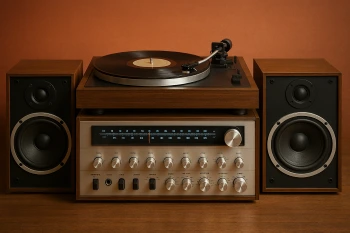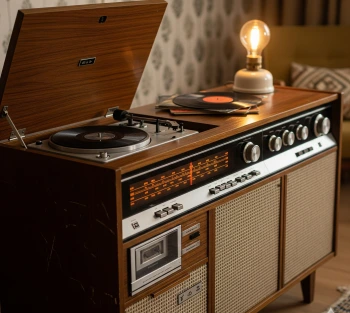Vintage Stereos to Avoid: A Collector’s Warning
The Vinyl Groove
Your Guide to the World of Analog Sound
Vintage Stereos to Avoid – A Collector's Warning Guide
Published on September 1, 2025 | By The Vinyl Groove Team

Navigating the world of vintage audio can be thrilling—but also risky. If you're building a vinyl setup, knowing which vintage stereos to avoid is crucial. This guide highlights common traps and helps collectors make informed choices.
For a deeper dive into building a quality analog setup, check out our companion guide: How to Build a Vintage Vinyl Collection.
A Quick Note:
This isn't an exhaustive list, and there are exceptions to every rule. This is a general guide to help beginners avoid the most common and costly mistakes.
1. Vintage Stereos to Avoid: The "All-in-One" Console Units
These furniture-style systems combine turntable, receiver, and speakers in one cabinet. They're charming but problematic.
- Low-Quality Components: Heavy tonearms and ceramic cartridges can damage records.
- Poor Acoustics: Shared enclosures cause feedback and vibration issues.
- Repair Nightmares: Proprietary parts are hard to replace, making repairs costly or impossible.

2. Vintage Stereos to Avoid: Late 80s / Early 90s "Black Plastic" Gear
After the silver HiFi era, many brands cut corners. Most consumer-grade gear from this time is best skipped.
- Brittle Plastics: Buttons and knobs crack easily.
- Difficult Repairs: Integrated circuits are hard to diagnose and fix.
- Inferior Sound: Prioritized flashy features over audio fidelity.
3. Turntables with "P-Mount" Cartridges
Convenient but limiting, these systems restrict your ability to upgrade or fine-tune performance.
- Limited Selection: Few cartridge options remain today.
- No Adjustability: Tracking force and alignment are locked in.
4. Obscure or "House" Brands
Stick with trusted names like Marantz, Pioneer, Sansui, Kenwood, and Technics.
- Lack of Documentation: Service manuals and schematics are often unavailable.
- Questionable Build Quality: Budget brands used inferior components.
By steering clear of these vintage stereos to avoid, you'll save time, money, and frustration. Focus on gear with proven reliability and sound quality. For community insights and troubleshooting tips, visit Audiokarma.org.
Happy hunting!
Similar Posts
1909-s VDB Lincoln Cent
Here we’re going to dive into the fascinating history of the United States 1909 S VDB Lincoln cent, a coin that has captured the hearts of collectors for over a century. And if you’re wondering why we’re tackling such a specific topic, it’s because we believe that there’s no such thing as a coin that’s…
How to Find Collectibles True Worth
ByTimThe Real Value of Collectibles Why Sold Listings Beat Price Guides Every Time When it comes to determining the true value of collectibles, there’s one fundamental truth that every collector, dealer, and enthusiast needs to understand: an item is only worth what someone is actually willing to pay for it. While this might seem obvious,…
1943 Steel Cents
Are you interested in the fascinating history of the 1943 Steel Lincoln cents? Well it’s about time someone took an interest in the story of these little metal disks that caused quite the stir back in the day. First things first, let’s get some background on these penny oddities. In 1943, during the height of…
United States Pre-1933 Gold Coins
ByTimPre-1933 Gold Coins: A Guide to Classic U.S. Gold Pre-1933 gold coins are some of the most historic and collectible U.S. coins. Struck before the Gold Recall Act of 1933, these coins are prized for their rich history, beautiful designs, and lasting value. Whether you’re a seasoned numismatist or just starting your coin collecting journey,…
One Ounce Gold Coins
ByTimHow to Choose One Ounce Gold Coins When comparing 1-ounce gold coins, there are several factors to consider. Here are the key aspects to evaluate: Purity Gold Content: The purity of gold coins is usually measured in karats or fineness. The most common pure gold coins are 24 karats (99.99% pure) like the Canadian…
Error Coins
ByTimUnearthing Treasures: A Journey Through the History and Collection of Error Coins In the realm of numismatics, where every coin tells a story, error coins stand out as unique anomalies, bearing witness to the intricacies and occasional mishaps of the minting process. These coins, often minted with imperfections or irregularities, have captured the fascination…

 '
' 


